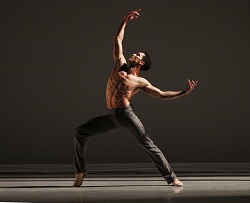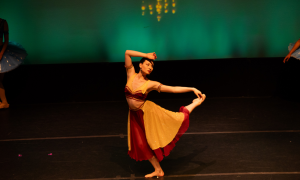By Laura Di Orio.
George Balanchine said, “See the music, hear the dance.” The choreographer, like many dancers, found inspiration for movement within music. To be able to move one’s body to music can be magical enough. And to be able to dance to live music is, for many dancers, a dream.
Here, Dance Informa speaks with professional dancers who enjoy the privilege of performing to live music. The Australian Ballet’s Brooke Lockett, Miami City Ballet’s Rebecca King and Joffrey Ballet’s Fabrice Calmels share their expertise and the joy of making the music come alive.

Brooke Lockett, dancer with The Australian Ballet, backstage during a performance of Sugar Plum. Photo courtesy of Brooke Lockett
Do you prefer dancing to live or pre-recorded music?
Brooke Lockett, Coryphee with The Australian Ballet
The positive to recorded music is you get an inner rhythm and timing, and the work becomes very consistent, and in some cases, almost predictable. You can never assume anything when it’s to live music. The tempo can be faster or it can slow down parts you prefer faster, but all issues aside, nothing gives me goose bumps more than the sound of a sublime live orchestra playing Tchaikovsky’s Swan Lake. The curtain goes up and the music floods onto the stage from the pit. It goes through your bones and brings everything you have been rehearsing to life.
Fabrice Calmels, Principal Artist at the Joffrey Ballet
(View Fabrice’s website here)
For me, it is preferable to dance to live music, but there are actually times when I find pre-recorded scores a safe alternative, like in a very difficult performance on tour.
For you, what is the biggest challenge of dancing to live music?
Rebecca King, Corps de Ballet dancer with Miami City Ballet
The music’s tempo can be a challenge. Even though the conductor knows exactly what the dancers need, the speed can still vary from performance to performance. It is our job to be completely in tune with the orchestra because you never know what is going to happen. Because the musicians, like us, are susceptible to human error, sometimes the music can sound different, which can catch the dancers off guard. This is the beauty of live theater – you never know what you are going to get.
For you, what is the greatest reward of dancing to live music?
Brooke Lockett
When a ballet is extremely difficult or you are quite nervous about a role, music is an incredibly powerful escape that has the ability to take you away to another place on stage. Without it, I don’t know that my profession would be as powerful or as rewarding.

Fabrice Calmels, principal artist with the Joffrey Ballet, in Jessica Lang's 'Crossed'. Photo by Herbert Migdoll
Fabrice Calmels
Here’s what is going on with live music: You have a full orchestra with different instruments working together as a team, following a score and led by a conductor, who, in turn, is watching and observing every move from us, the dancers. With the conductor’s expertise, he is able to match the choreography with the music and create the flow. For me, it is communication at its best.
How does dancing to live music compare to dancing to recorded music?
Fabrice Calmels
The beauty of live music is the clarity of the sound, and performing at Chicago’s Auditorium Theater, we have one of the best engineered houses in the world. It was built for live music, and its acoustics are incredible. Live music is simply rich. There is something about the quality of instantly created sound and vibration that is priceless. Recorded music has so many factors that come into play, such as how well the track may be recorded, the quality of the player or speakers, static, or speakers that sometimes do not separate well the low-bass from the mid-bass.
Brooke Lockett
The sound is the biggest comparison. It’s like when I see a live music concert, and no matter how loud I play the CD after the show I can never recreate that same feeling or volume. You hear so many more elements and instruments when it’s live.

Rebecca King, dancer with Miami City Ballet. Photo by Susan Stocker, Sun Sentinel
For a piece that you will eventually perform to live music, what is the process of incorporating the musicians or conductor into the rehearsals?
Rebecca King
Our conductor, Gary Sheldon, spends a lot of time with us in the studio during rehearsals. He not only comes in the week before we take a program to the theater, but he also tries to be around when the choreographer or repetiteur is in town working with us. He has told me that he finds it very important to familiarize himself with our works as much as possible. This makes it easier for him to know when certain cues are coming up, or what tempos different dancers are comfortable with.
Do you usually try to build some kind of rapport with the conductor and musicians?
Brooke Lockett
Absolutely. Sometimes you are feeling a little flat or have an injury, and it’s important for them to know those things. And for those shows when you are on fire and loving it, you can really bounce off one another.
Rebecca King
I think all the dancers at Miami City Ballet have a great rapport with our conductor. He always makes an effort to say hello in the hallways, wish you “merde”, or good luck, before a show, and commend you on your performance after the curtain comes in. You can tell he really makes an effort to know the dancers, which we really appreciate. We don’t have a lot of interaction with the musicians, but we do always make an effort to thank them when we see them leaving the pit. Without them, their talent and extraordinary effort, we would not be able to do what we do.
What’s been a memorable moment of performing to live music?
Fabrice Calmels
The beginning of Lar Lubovitch’s production of Othello starts with a very powerful overture by the orchestra. This leads to the first dance, “The Prayer”, when Othello rises from a kneeling position for a stunning solo done only by creating circular movement with his arm. In every rehearsal and performance, I become Othello in that moment, located near the first panel of the stage, waiting for the main curtain to go up. I am already kneeling with both hands gathered as a prayer resting against my forehead. The orchestra is playing the score, the drums become explosive and so powerful that I feel my hand bouncing up and down from the vibration they create from underneath me. It completely gets in me, my heart begins to beat like a drum. It’s an experience unlike any other.
Brooke Lockett
We had a guest conductor for a season of Swan Lake once and we had all been talking about how slow it was, and in our final Act II entrance as a Cygnet it was like we were doing Willies from Giselle, it was so slow. We had the giggles for the entire entrance and had to quickly pull ourselves together.
Rebecca King
My first year in the company, we were performing Balanchine’s Symphony in 3 Movements, with a score by Stravinsky. Ask any dancer and he/she will tell you that the complexity of Stravinsky’s music has no doubt kept them up at night. Trying to memorize every note and count is no small feat. During a section of the first movement, the three principal couples were on stage, and there was a brief pause followed by a change in the music. Something was missing. The dancers suddenly realized that the instrument that was, at that moment, in charge of keeping the beat was nowhere to be found. They started counting aloud to each other to keep themselves in sync. Thankfully, this confusion only lasted a few bars before another change in the music arrived. We found out later that the musician playing the instrument in question had fallen asleep in the pit!
Top photo: Fabrice Calmels, principal artist with the Joffrey Ballet, in Edwaard Liang’s Age of Innocence. Photo by Herbert Migdoll.
Published by Dance Informa digital dance magazine – dance news, dance auditions & dance events for the professional dancer, dance teacher and dance students.













